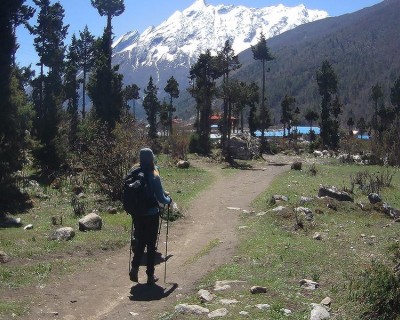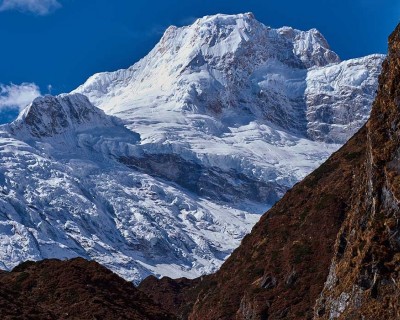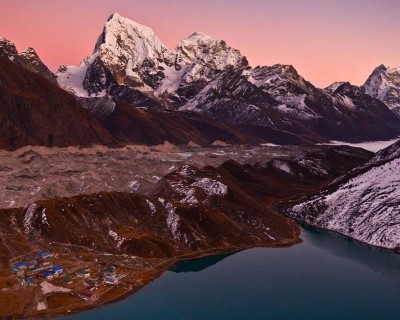How many days do we walk to climb Mount Everest?
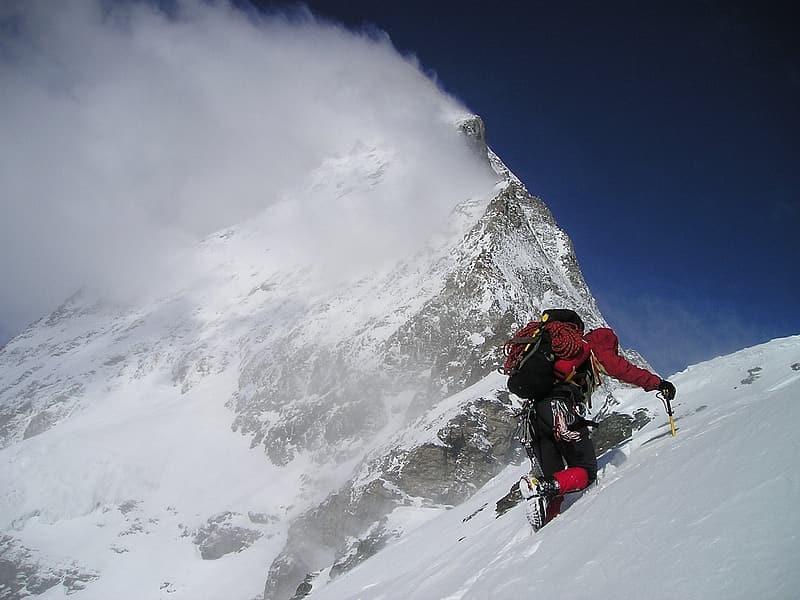
Climbing Mount Everest takes about 66 days. The climb to Mt. Everest is not as easy as it looks. The high altitude of the region causes the oxygen levels to decrease, making it harder for breathing. Technical skills like using fixed ropes, ice axes, and crampons are required for this journey.
The Everest Base Camp is situated at the foot of the icefall at the height of around 5300 meters. Usually, you need 4-5 days at the Base Camp for acclimatization before you climb the Khumbu icefall. After climbing the Khumbu icefall, you will come back to the Base Camp for rest.
You will climb up to Camp 1 and stay at Camp 1 for two nights. You will then return to Base Camp. You will again walk to Camp 1 and rest for the night at Camp 1 and climb to Camp 2 prior to returning to Base Camp. This is the acclimatizing period. This process makes the ascent quicker than before. Before you actually begin the climb to the summit of Everest, the same process continues for a few weeks.
The acclimatization period is the most important as well as the most time-consuming period in the expedition. To retain energy, you will need to take rest at different Camps rather than head down continuously. The North Ridge route is another route which is technically challenging due to a rocky path.
Highlights of Climbing Mount Everest
- Summit world highest peak Mount Everest (8,848m).
- A scenic flight to Lukla from Kathmandu
- Tengboche Monastery.
- Awesome views of the Khumbu icefall.
- Best Sherpa support and logistics while on climbing period
- Explore Sherpa’s local life.
- Explore the beautiful Namche Bazaar, Khumbu Glacier, and enjoy the sunset views in Kalapathar.
- Led by experienced guides who have stood on the summit of 8000 meters peaks
- Go sightseeing around the Kathmandu Valley.
- Explore the UNESCO world heritage sites.
Detail Itinerary To Climb Mount Everest
Day 01: Arrival at Kathmandu.
You will arrive in Kathmandu, and our staff will pick you up from the airport. As you reach the hotel, our team will brief you about the journey. Then you will prepare for the expedition. You can rest for a while and stroll around the hotel area. Stay the night at the hotel.
Day 02: Kathmandu Sightseeing.
A local guide will provide you a sightseeing tour of the Kathmandu valley. You will have a chance to visit various World Heritage Sites in Kathmandu. You will go to Pashupatinath, Swayambhunath, Boudhanath, and different Durbar Squares of Kathmandu Valley. You will get the first-hand experience of the architecture, culture, and culinary arts of the local Newar community—overnight in a hotel.
Day 03: Shopping and trip preparation.
At first, our representatives will organize a team meeting where you will meet team leaders and fellow climbers. Expert climbers will brief you about the nature of the expedition, team composition, and equipment.
You can buy all those items that you might need during the trip. Experts will check whether the stuff you bought is feasible and in good working condition. You might want to replace them with new ones if the equipment doesn’t match the standard.
Day 04: Go to the Ministry of Tourism and Official briefing in the Ministry of Tourism.
You will visit the ministry of tourism, where an official briefing will be organized with the government officials in the Ministry of tourism. You will get briefed about the standard procedure of the Everest expedition and get to know guidelines.
Day 05: Fly from Kathmandu to Lukla and trek to Phakding (2640m).
We will fly from Kathmandu to Lukla on an adventurous and scenic flight. The Tenzing Hillary Airport, with just 527m of a runaway, is one of the smallest airports in the world. From Lukla, we will start our trek and walk for 4 hours towards Pkhading. You will walk through the trails above the Dudh Kosi valley until you reach the village of Phakding.
Day 6: Trek from Phakding to Namche Bazaar for 6 hours (3446 meters).
The trek to Namche Bazaar from Phakding begins early in the morning. The trail passes through the Dudh Koshi river, crossing the famous Hillary suspension bridge at a height of 125 meters. Along the way, we can enjoy the view of Mt Thamserku (6618m). We pass through the remote villages of Jorsale and Monjo to reach the entrance of Sagarmatha National park. The trail moves along the alpine forests to arrive at the junction of Dudh Koshi and Bhote Koshi rivers. Finally, after walking for 6 hours, we reached Namche Bazaar. Namche is known as the trading town in the Everest region. Overnight at Namche in a guest house.
Day 7: Acclimatization day and rest at Namche Bazaar.
On this day, we acclimatize at Namche Bazar to adjust our bodies to the high altitude of the trek. However, we keep moving and explore Namche Bazaar and hike to Thame. Namche Bazaar is considered the main attraction of the Khumbu region with numerous cafes, government offices, banks, etc.
As we reach Namche, we can also visit the Khunde Hospital, which was set up by Sir Edmund Hillary. We can also visit the Sherpa Cultural Museum. We can also take a short hike to the Syangboche to the Everest View Hotel. The breathtaking views of the entire Himalayan range, including Everest, Ama Dablam, Nuptse, Lhotse, Kusum Kangaru, Thamserku, will fascinate you.
Day 8: Trek from Namche Bazaar to Tengboche (3800m).
Today, we start our trek towards Pangboche from Namche Bazaar, enjoying spectacular views of Mt Everest, Lhotse, Nuptse, and Ama Dablam. We will walk in the trail along with the rhododendron trees overlooking the high Himalayas. We might also explore some wild animals such as Danphe pheasant, musk deer, or a herd of Himalayan Thar.
We finally arrive at the major trail junction to Gokyo valley i.e., Sansa and Everest Base Camp. We walk for 6 hours following the trails through pine forests till we reach Tengboche. Overnight in Tengboche.
Day 9: Trek from Tengboche to Pheriche (4243m).
After breakfast, we start our trek from Tengboche to Pheriche. We will go through steep climbs as the altitude rises above 4000m. We will go through small settlements with mani walls and chortens.
The trail then gradually descends to Dingboche. We will cross the Imja river through the suspension bridge. We will then climb past mani stones to reach Pangboche. We will visit the oldest gompa inPangboche. The trail then finally climbs to Pheriche. After 5 to 6 hours of walking, you will get to Pheriche. Overnight in Pheriche.
Day 10: Trek to Lobuche from Pheriche (4930m)
On this day, we continue our trek to Everest Base Camp. Walking for a while, we will reach Dughla. It is located below the Khumbu glacier. We resume our trek to a steep climb up the glacier moraine after having lunch at Dughla. After walking for 4 to 5 hours, the trail leads us to a small cluster of tea houses located at Lobuche.
Day 11: Trek from Lobuche Everest Base Camp (5360m) – Camping Accommodation
On this day, we trek early morning from Lobuche to Everest Base Camp, reaching Gorak Shep and Kalapathar. After breakfast, we will hike up the rocky path above the valley. We can see the icebergs and frozen ponds of the Khumbu Glacier.
You will reach Gorak Shep after a short trek. Gorak Shep is where Edmund Hillary and Tenzing Norgay set up their Camps. You will ascend in a rocky path, and after an uphill climb for half an hour, you reach Kalapathar. You can enjoy the panoramic scenes of the Himalayan range in Kalapathar(5545m). You can take a break for some time and take as many pictures as you can. The view of Mt Everest in a stunning closeup along with MtNuptse and Mt Lho-la will captivate you.
After a break, we will resume our trek to Everest Base Camp. You will go through ice pinnacles and crevasses of the Khumbu Glacier. The Everest Base Camp will also meet fellow climbers from various other expedition teams. After trekking for 7 to 8 hours in the snow, you will see the base camp. You will see the colorful tents on a backdrop of white snow mountains. You will then set up your tents and accommodate ourselves.
Day 12-60: Climbing Period to reach Mt. Everest (8848m).
The route is a trekking route with less danger once you pass the Khumbu icefall. However, there are a few seracs and crevasses bridged by ladders. Along with rocky sections protected with fixed lines, you will also find a couple of short ice cliffs at around Camp 3. The chances of high altitude sickness can be high and fatal. The weather in the mountains can be unpredictable and changeable at times.
You will walk the most dangerous part of the climb, i.e., Khumbu icefall. The steep glacier with large crevasses and deceptive unstable seracs makes this a complicated path. The Sherpas will install ladders across crevasses and aid the process along with vertical seracs ice walls at the beginning. With this process, the route through the icefall will be set and make the climbing efficient, safe, and effective.
You will ascend to the summit in the early hours of the morning because the ice will be well frozen. The sunlight in the afternoon warms the area that makes the friction between the ice structures less, which may cause crevasses to open or blocks of ice to fall. These factors make the Khumbu icefall quite dangerous to attempt in the presence of sunlight in the afternoon.
To avoid strong afternoon winds at the summit, we start as early as possible. You will be coordinated by expert climbers throughout the expedition. The Sherpa guides will carry our equipment and will help us throughout the journey. There will be four Camps set up on the ascent to the summit.
Camp 1 : 6400m (20996ft)
Camp 1 is set up at the top of the Khumbu icefall. You will see a horizontal level of heavy snow surrounded by the mountain walls. The weather in this region is warm during the day. However, the nights are cold due to the strong gust of winds flowing on the mountain. You can see the glacier between Camp 1 and Camp 2 is flat. You will also see a large crevasse close to Camp 1 get fixed with ladders. You can hear a cracking sound that arises from underneath the tents. Camp 1 is a transition area before moving to Camp 2, where you can rest up before moving forward.
Camp 2 : 6750m
Camp 2 is at the foot of the Lhotse wall or the lateral moraine at the bottom of the west ridge. Spectacular views of Mt Lhotse is seen from the safe and sheltered location. You will set the camp with individual tents. Camp 2 is the base for acclimatization climb to Camp 3 and also the main acclimatization Camp.
Camp 3 : 7100m (23292ft)
You can achieve Camp 3, i.e., adjoined to the Lhotse divider with the help of a fixed rope. You will reach Geneva Spur towards the east after climbing forward. The oxygen levels will drop fast as the altitude increases. There is supplementary oxygen in case of any inconvenience. But, most climbers don’t require supplementary oxygen till they reach Camp 4. The glacier is crossed with a 40 degree 600m climb on the snow through the right side. The route seems to be safe with a couple of ice cliffs less than 3 meters.
Camp 4 : 8400m (27560ft)
The last Camp before the summit in Camp 4. Situated on the sharp-edged South col, Camp 4 is also the most dangerous segment of the climb. The winds are strong and violent here. It is only 450 meters away from the summit. The best route to reach the summit is the narrow southeast ridge. This path makes it easy to reach the summit of Everest. Sir Edmund Hillary and Tenzing Norgay had also used this same route in 1953.
The climb to the summit starts at the last section of the southeast ridge, i.e., from Camp 4. It is mostly steep with a rock section and snow. The entire route is fixed with ropes. This is done for the safety of climbers. There is supplemental oxygen available as almost every climber gets affected by altitude sickness due to lack of oxygen.
Day 61: Return from Everest Base Camp and trek down to Pheriche
We will have to trek downhill to the village of Pheriche from the base camp. The trek will be naturally faster. We would have a change in elevation of almost 1000m, which would not have been possible if we were ascending. Spend the night at Pheriche.
Day 62: 6-7 hours Trek from Pheriche to Namche Bazaar
On this day, we will be descending from Periche to Namche Bazaar. The walk is almost 6 to 7 hours. The oxygen levels increase as we go downhill. As we descend, we will be able to breathe more naturally. The altitude sickness will also gradually disappear. We will pass through the Tengboche monastery and other landmarks to reach Namche Bazaar. You will be able to take a hot shower and use wifi at Namche. Overnight in Namche Bazaar.
Day 63: Trek back from Namche Bazaar to Lukla.
We will trek back from Namche Bazaar to Lukla to Phakding Village. The descent from Namche to Dudh Koshi can be quite challenging. The path will become more smooth after crossing the suspension bridge. Enjoying the captivating scenes of the snow-capped mountains for one last time, we walk through rhododendron forests. We reach Lukla after trekking for 5 to 6 hours. Overnight in Lukla.
Day 64: Fly from Lukla to Kathmandu.
On this day, you will take a flight back to Kathmandu from Lukla. You will go on a thrilling and scenic flight looking at the snow-capped mountains for the last time during your trek.
Day 65: Free day in Kathmandu
You will have a free rest day in Kathmandu. You can either relax or go last-minute shopping in Thamel, which is a tourist hub in Kathmandu. You will enjoy the celebratory dinner in the evening.
Day 66: Final Departure.
Our representative will drop you at the airport according to your flight timing, where you may board your flight back to your destination.
Difficulties to Climb Mount Everest
Altitude Sickness
Altitude sickness is the biggest risk to Mt. Everest climbers. This might affect many aspects of your health. You can feel less oxygen in the air as you reach a higher altitude. Your body can slowly adapt to this but only up to a point.
As you will walk for a lengthy period, you are unlikely to ever feel yourself above base camp. In the altitude above 8,000m, they are beyond the limit of their adaptation ability to the altitude.
Temperature
In Everest, the air temperature drops by roughly 0.65C per 100 meters of height gained. The temperature is about 57 degrees Celsius less than at sea level. It is cold up there. And you will need to prepare very well for cold situations. There are high chances that you will fall sick. So you need to be very careful early during the climb.
Falls
The highest cause of death on Everest is by falling. These can happen when actually climbing on the high ridges, and also in careless moments at the higher camps. Stepping out of their tent for a minute at night onto the ground covered in ice is a particular example. Always make sure to have attention on your footwork, double-checking knots, and some experience on snow and ice are crucial steps for reducing this risk.
Crevasses
These are the cracks that appear in glacial ice. It is also risky as it threatens to swallow careless or unfortunate climbers. You will get to see these in the Khumbu Ice Falls and the Western Cwm. Teams often tie ropes between each of their members to aid safe travel across glaciers. This is done so they can drag out anyone unlucky enough to take a fall.
Which is the Best Time to Climb Mount Everest?
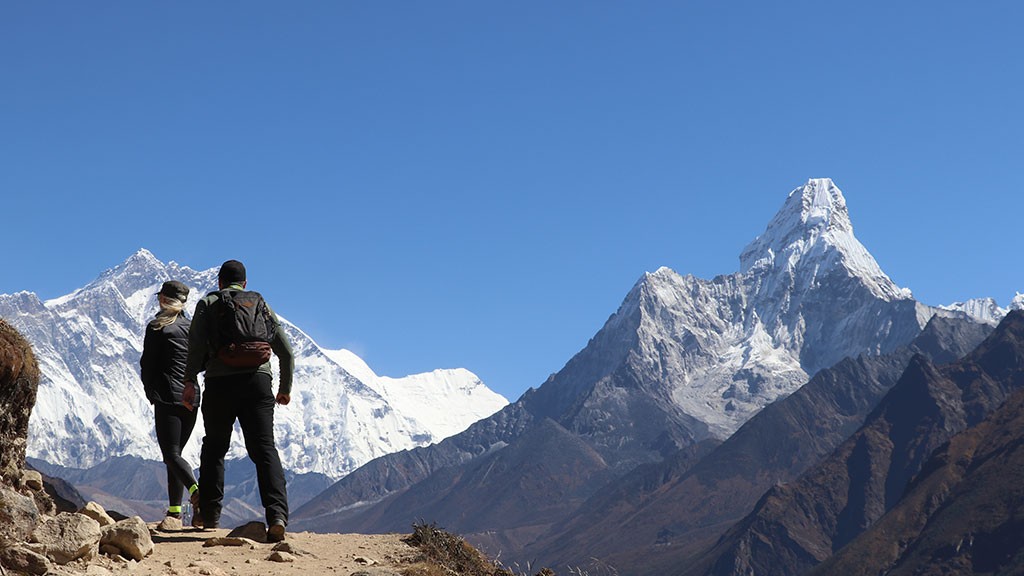 Weather conditions at the Everest Summit are susceptible to unpredictable changes. Determining the best time for the expedition depends on the unpredictable, extreme climate conditions and changing temperatures. The temperature at the summit is at an average of -36 degrees Celsius in January, which is the coldest month, which can drop to -60 degrees. The average temperature is -19 degrees Celsius in July.
Weather conditions at the Everest Summit are susceptible to unpredictable changes. Determining the best time for the expedition depends on the unpredictable, extreme climate conditions and changing temperatures. The temperature at the summit is at an average of -36 degrees Celsius in January, which is the coldest month, which can drop to -60 degrees. The average temperature is -19 degrees Celsius in July.
The best time to climb Mt Everest is in the spring season. The months from April to Mayare the best time to climb the summit. The peak is mostly visible and clear during this time. Besides, from September to October in the autumn season is also suitable for climbing Mt. Everest. The autumn season comes after the monsoon season and is the peak time for the ascent. The weather is moderate, and there is no chance of rainfall.
Tips to Climb Mount Everest
- Always make sure to walk at a slow pace and do not rush to reach the destination. The key to complete the trek is to walk slowly.
- Maintain a high level of non- alcoholic fluid consumption. Alcoholic consumption will only dehydrate your body.
- Doing physical preparation before the climb to Mount Everest will be very helpful.
- Make sure to engage in physical activities such as running, swimming, cycling, etc. three weeks before your trek.
- To prevent yourself from altitude sickness, carry some Diamox tablets, and drink plenty of water.
- Always carry rain gear if you are trekking in monsoon season.
- Always carry appropriate trekking gear with you.
For those seeking an additional level of challenge and excitement in their Himalayan adventure, the Everest Three High Passes Trek is a fantastic choice. This trek not only encompasses the traditional Everest Base Camp route but also traverses three of the highest passes in the Everest region, providing stunning vistas and a unique experience of the region's varied landscapes.
Final Say
Climbing Mt Everest is serious and requires extreme guidance, commitment, and training. We will make sure you of the full expert assistance in your successful ascent of the highest mountain peak in the world. For further inquiries, contact us we will get back to you.
Few articles you may like:




 Weather conditions at the Everest Summit are susceptible to unpredictable changes. Determining the best time for the expedition depends on the unpredictable, extreme climate conditions and changing temperatures. The temperature at the summit is at an average of -36 degrees Celsius in January, which is the coldest month, which can drop to -60 degrees. The average temperature is -19 degrees Celsius in
Weather conditions at the Everest Summit are susceptible to unpredictable changes. Determining the best time for the expedition depends on the unpredictable, extreme climate conditions and changing temperatures. The temperature at the summit is at an average of -36 degrees Celsius in January, which is the coldest month, which can drop to -60 degrees. The average temperature is -19 degrees Celsius in 